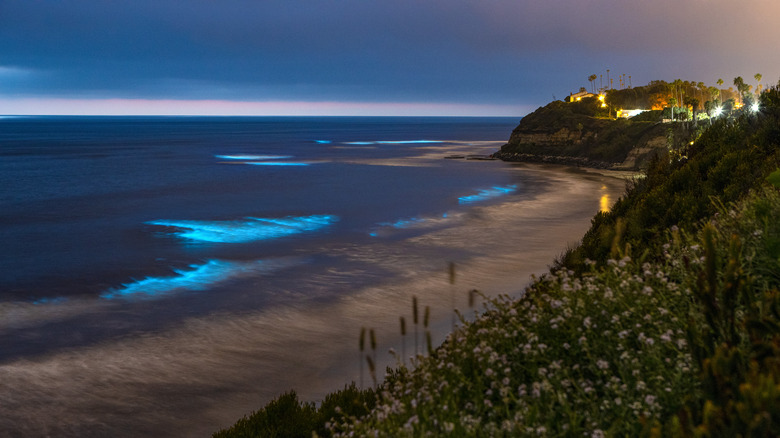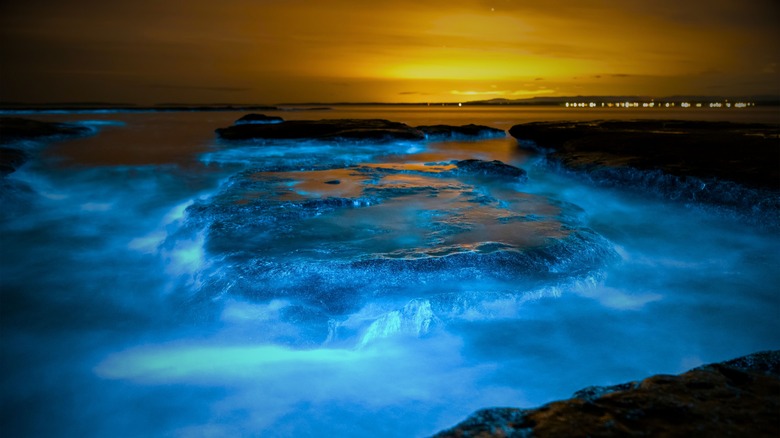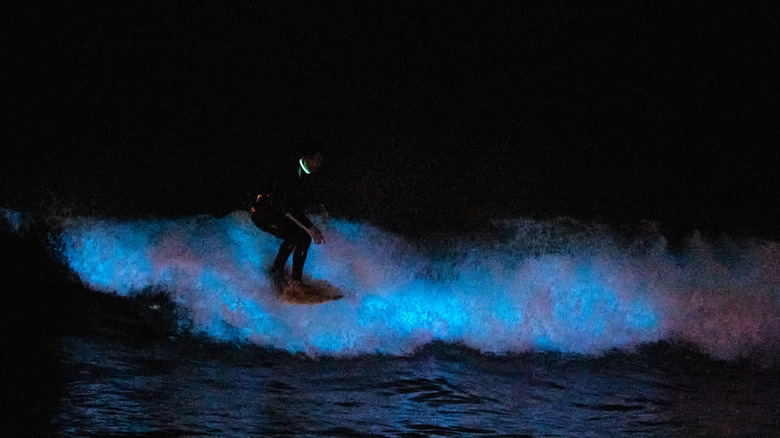The Beaches In California Where You're Most Likely To See Bioluminescent Waves
California, renowned for its stunning 840-mile coastline and diverse Pacific Ocean marine life, offers a unique natural phenomenon that enchants Westside locals and international tourists: bioluminescent waves. These glowing waves create a surreal and magical experience as they light up the night sea with a mesmerizing blue glow. With over 420 public beaches to choose from, where do you get the top-tier ticket to this natural theater? If you're eager to witness this spectacle, these are some of the best beaches in California where you're likely to see bioluminescent waves.
First, it's important to understand what, how, and why this natural phenomenon happens. Bioluminescent waves are created by tiny organisms in the water called phytoplankton. These are essentially microscopic algae — there are billions in the world's oceans, even more than stars in the sky — that produce light through chemical reactions in their bodies, a result of the light-exuding molecule luciferin and an enzyme called luciferase. The magical sea firefly's sparkle lasts for a tenth of a second!
When these plankton, specifically dinoflagellates of the Lingulodinium polyedra species, are disturbed by waves or splashing, they emit a brilliant blue or green light — sometimes even red. Other creatures, like jellyfish, certain fish, and squid, also have bioluminescent properties. Bioluminescent waves are common when plankton blooms in coastal waters worldwide, especially in places like California and the Maldives — Jamaica even has the brightest glowing lagoon in the world. Bioluminescence serves as a defense mechanism to confuse predators, attack prey, or entice potential mates.
California's most bioluminescent beaches, from San Diego to Monterey
La Jolla is one of the most famous spots in California for observing bioluminescent waves. This picturesque beach town, known for its unique shops, restaurants, and museums, transforms into a natural light show during certain times of the year. The calm waters of La Jolla Cove and Shores are prime locations for the microorganisms responsible for the glowing effect to thrive. It's also well known for its sea caves and seals! Not far from La Jolla, close to the Torrey Pines State Reserve, Torrey Pines State Beach is another excellent location for witnessing bioluminescence. It also has a popular beachside trail that takes you on a hike along the California coast. Other honorable mentions in the area include North Ponto Beach and Carlsbad State Beach.
Mission Bay offers a different experience from the open ocean beaches, with its calm, lagoon-like waters. The bay's sheltered environment allows for higher concentrations of bioluminescent plankton. Similarly, Tomales Bay, located north of San Francisco in Marin County, is another fantastic option. Bioluminescent tandem kayaking tours, offered by providers like Blue Waters Kayaking, allow you to experience the bioluminescent show as closely as possible, as each paddle stroke can create a luminous trail in the water. Nearby, Point Reyes National Seashore is another dependable location that even has a beachside campground (that's very much worth the trek). Imagine pitching your tent oceanside and having front-row seats all night long to this spectacular natural phenomenon.
Tips for viewing bioluminescent waves
To increase your chances of witnessing bioluminescent waves at some of these California beaches, consider the following tips. First and foremost, check local reports. Bioluminescence is a natural phenomenon, and, unfortunately, it can be pretty unpredictable. Check local news, social media (specifically Instagram or Twitter), or forums like Reddit for recent sightings. Local aquariums, such as Birch Aquarium, Monterey Bay Aquarium, and the Aquarium of the Pacific, tend to post updates about bioluminescence events, so review their websites and social media feeds as well. Ideally, visit during the warmest months of the year, during summertime and early fall. Bioluminescent plankton thrives in warmer waters, so this will increase the probability.
It might also be tempting to jump in and swim in these warm, sparkling waves. However, one of the organisms that produce bioluminescence, Lingulodinium polyedra, secretes a neurotoxin called yessotoxin, which may have health implications on humans that are not fully understood yet. The water can also get slightly smelly during these bioluminescent events as the algal blooms are decomposing, so whether you want to jump in or not is a personal decision. The optimal viewing time is at night. The glowing effect is best seen in complete darkness, as far away as possible from any light pollution. Two hours after sunset and just before the moon rises are recommended. Also, avoid nights with a full moon, as the bright moonlight can wash out the bioluminescence, one of the strangest natural wonders of the world.


